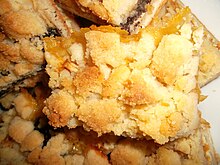crumble cacke
Streusel cake is a flat sheet cake made of fine yeast dough with a topping of streusel , a crumbly mixture of sugar , fat and flour . It used to be known mainly in Saxony and Silesia , but is now popular all over Germany. It is typically one of the unfilled sheet cakes, but crumble cakes are also made with different types of bases under the crumble.
preparation
To prepare crumble cake, first roll out the yeast dough on a baking sheet and let it rise for a while. Then the crumbles (made of sugar, fat and flour in a ratio of 1: 1: 2) are sprinkled on the dough base, whereby the dough is moistened beforehand so that it sticks better. Finally, the cake is baked at two-thirds heat at about 220 ° C. Numerous agents can be used to moisten the dough, which also contribute to the refinement of the taste: water, milk, cream, vanilla cream , ice cream , sugar or honey water or jam . After baking, the cake can be sprinkled with powdered sugar or frosted .
Often butter is used as fat, one also speaks of butter crumble and butter crumble cake. According to the guiding principles of the German Food Book, butter crumb cake in dough and crumble must contain at least 30 parts of butter or corresponding amounts of pure butter or butterfat per 100 parts of ground cereal products and / or starch. It must not contain other fats.
Modification through documents
- Streuselauflagen also attached to fruit cake as apple pie , poppy seed cake , rhubarb pie or crumble cake with apricots , plums, cherries (to be halved and pitted launched), but also blueberries or currants .
- A base made of vanilla cream or pudding is also common .
- Silesian streusel cake has streusel on a quark pad.
history
Although the invention of the streusel cake is often attributed to the Silesian cuisine, there is no written evidence for this assumption. “ Even if it is no longer possible to say exactly where the crumble cake was baked for the first time, it was one of the most famous home-baked cakes in the 19th century and later both in Silesia and in the neighboring Prussian provinces. From there, the crumble cake spread further. The latter is explained (...) among other things with the migration movements of the Silesians to other regions. "
The crumble cake appeared in Upper Saxony , the oldest known testimony is in Kaspar Füger's “Nawe Zeitunge” published in 1584 , where two farmers from Meißen tell: “We eat ... Christwecken or Streusselen”. The Saxon crumble cake is one of the most famous of the Saxon cakes.
By the 19th century at the latest, it was well known and widespread in Silesia and was baked on numerous occasions in private households, including at fairgrounds . The poet Eichendorff reported in a letter in August 1857: “ Today is the parish festival of the castle chapel, so there was a big cake for breakfast. “Other occasions included Thanksgiving , weddings, and baptisms . The Silesian dialect poet Hermann Bauch (1856–1924) even dedicated his own poem to “Sträselkucha”. The crumble cake for the 19th century is also documented in East and West Prussia .
By the beginning of the 20th century at the latest, the crumble cake was also well known in the Rhineland , where it was often eaten after funerals , which is why it was nicknamed "funeral cake " there.
Crumble cake before the EGC
In 2011, the Central Association of the German Bakers' Trade filed a lawsuit with the EGC in Luxembourg because the EU Commission had registered the Polish name “Kołocz śląski” as a protected geographical indication. With success: the designation “Silesian Streusel Cake” was an editorial translation error in the German version of the EU Official Journal (“Kołocz śląski” or “Kołacz śląski” simply means Silesian cake ). The CFI decided with the judgment of 7 October 2015 that Silesian Streuselkuchen not the protected geographical indication "kołocz śląski" or "Kołacz śląski" are detected and may be manufactured by the German bakers and markets.
Web links
Individual evidence
- ^ IREKS Arkady Institute for Bakery Science (ed.): IREKS ABC of the bakery. 4th edition. Institute for Bakery Science, Kulmbach 1985
- ^ A b Claus Schünemann, Günter Treu: Technology of the production of baked goods. Specialized textbook for bakers . 10th edition. Gildebuchverlag, Alfeld / Leine 2009, ISBN 978-3-7734-0150-2 , p. 271–273 ( limited preview in Google Book search).
- ↑ German Food Book, Guidelines for Fine Baked Goods , Section II 12
- ^ Franz Maier-Bruck : The great Sacher cookbook . Wiener Verlag, 1975, p. 532 .
- ↑ Irene Krauss : Chronicle of beautiful baked goods . Stuttgart 1999, p. 79
- ^ Hermann Teuchert: The language remnants of the Dutch settlements of the 12th century . Böhlau Verlag, 1972, ISBN 978-3-412-95672-1 , p. 297 .
- ^ Tilman Allert: Culinary studies: research, teaching, practice . LIT Verlag Münster, 2008, ISBN 978-3-8258-1081-8 , pp. 291 ( google.de ).
- ↑ Streussel. In: Jacob Grimm , Wilhelm Grimm (Hrsg.): German dictionary . tape 19 : Stob – Strollen - (X, 3rd division). S. Hirzel, Leipzig 1957 ( woerterbuchnetz.de ).
- ↑ Details. Retrieved January 4, 2019 .
- ^ Complete works of Baron Joseph von Eichendorff. Historical-critical edition. Edited by Wilhelm Kosch and August Sauer in conjunction with Philipp August Becker . Volume 12: Letters from Eichendorff. - Letters from Baron Joseph von Eichendorff . Published by Wilhelm Kosch. Regensburg, p. 243
- ↑ Crumble cake. In: mein-skerbersdorf.de. Retrieved January 1, 2017 .
- ↑ a b Irene Krauss: Chronicle of beautiful baked goods . Stuttgart 1999, p. 76 ff.
- ↑ Bakers are allowed to bake Silesian crumb cake. In: dhz.net. Retrieved December 23, 2018 .



